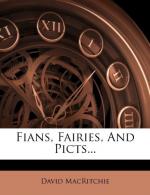“An ancient dwelling, semi-subterranean, exists at Nisibost, Harris [and is described in vol. iii. of the Proceedings, p. 140].... A still finer example exists near to Meall na h-Uamh, in South Uist.... The bo’h, or Pict’s house, as it would be called in the Orkneys—but the name is unknown in the Long Island—that I am about to describe lies less than half a mile above the shepherd’s house; but so little curiosity had that individual that he was entirely unacquainted with it; and I believe it would never have been found by us but for a little terrier (in its etymological sense, of course) of a daughter. The child was only acquainted with the two here drawn [of which the other—viz., Uamh Sgalabhad, is here reproduced as Plate I., frontispiece]; but there may be many more waiting the researches of the zealous antiquary.” (Captain Thomas, op. cit., p. 165.)
[Illustration: PLATE XIII.
GROUND PLAN AND ENTRANCE OF UNDERGROUND GALLERY AT PAIBLE, TARANSAY, HARRIS.
“The drawing is from a photograph of the entrance, which is 2 feet 10 inches high and 1-1/2 foot broad. The sea flows up to it at high tides.”]
PLATE XIII.—Underground Gallery at Paible, Taransay, Harris.
(From Plate XXIX. of Vol. VII. of Proceedings of the Society of Antiquaries of Scotland, First Series.)
Describing this earth-house, Captain Thomas says:—“The drawing is from a photograph of the entrance, which is 2 feet 10 inches high and 1-1/2 foot broad. The sea flows up to it at high tides. On crawling in, there is seen the usual guard-cell (b), close beside the entrance, but so small that we may be sure the sentinel, if there was one, must have been a light weight; in fact, we are almost driven to the conclusion that there were no Bantings in those days. This guard-cell is but 2 feet 5 inches high, and 3 feet in width. The gallery then turns at a right angle to the left hand. We excavated it for 22 feet.... When digging, we came upon two broken stone dishes (corn-crushers?) now in the Museum [Society of Antiquaries of Scotland]; and above the gallery were most of the bones of a small ox, placed orderly together.... Bones of the seal were common, and a few of the eagle.” (Op. cit., p. 169.)
[Illustration: PLATE XIV.
MAES-HOW, ORKNEY.]
[Illustration: PLATE XV.
INTERIOR OF MAES-HOW, ORKNEY
(Facing inner doorway of gallery).
Cell or Bed in Wall.]
[Illustration: PLATE XVI.
SECTIONAL VIEW AND GROUND PLAN OF MAES-HOW.]
PLATES XIV., XV., AND XVI.—Maes-How, Orkney.
These plates represent the “Pict’s house” referred to by Captain Thomas (pp. 50-51, ante), with regard to which he says:—“Maes howe was for three families—grandees, no doubt; but the numbers it was intended to hold in the beds may be learned by comparing them with the Amazon’s House, St. Kilda.”




